
Return to Gallery
Display Contents
Middle Bronze Age ring-stamp decorated pottery vessels
Birchington
Shuart/Netherhale
Margate Football Club
Westwood Cross
Manston Road Ramsgate
An overview
Artefact scales in centimetre divisions
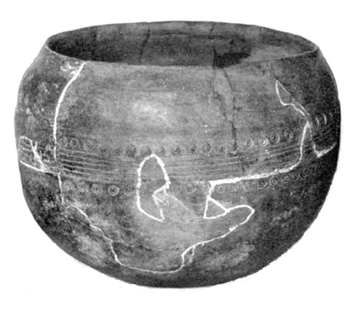
Powell-Cotton and Crawford 1924 (photographer unknown)
The vessels shown on this
page are
characterised by the presence of a rare decorative motif. They feature
the
repeated application of a stamp which was carved with either two
or three concentric circles in relief.
Four individual ring-stamped sherds have been recovered from archaeological sites on Thanet and these in turn are thought to represent a vessel type of which only one largely complete local example is known - the Birchington bowl (pictured above).
The five known examples of this vessel type on Thanet are:
Four individual ring-stamped sherds have been recovered from archaeological sites on Thanet and these in turn are thought to represent a vessel type of which only one largely complete local example is known - the Birchington bowl (pictured above).
The five known examples of this vessel type on Thanet are:
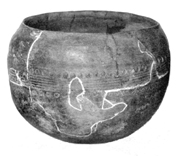
Powell-Cotton and Crawford 1924
Photographer unknown
A largely complete bowl was
recovered at Birchington
'three feet below the surface in Southern Brickfield' in 1904.
The decoration 'consists of six rows of parallel grooves around the middle of the vessel, with a single row of stamped circles (two concentric rings) above and below' (Powell-Cotton and Crawford 1924).
This bowl held a hoard of fourteen intact bronze Palstaves, no two of which were identical. The axes have been dated to circa 1300-1100 BC.
The find can be seen on display at the Powell-Cotton Museum at Quex Park, Birchington.
Powell-Cotton and Crawford 1924.
The decoration 'consists of six rows of parallel grooves around the middle of the vessel, with a single row of stamped circles (two concentric rings) above and below' (Powell-Cotton and Crawford 1924).
This bowl held a hoard of fourteen intact bronze Palstaves, no two of which were identical. The axes have been dated to circa 1300-1100 BC.
The find can be seen on display at the Powell-Cotton Museum at Quex Park, Birchington.
Powell-Cotton and Crawford 1924.
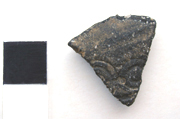
Excavation led by David
Perkins, Thanet Archaeological Unit; (NHF79).
The excavation of a ditched enclosure on the boundary between Shuart Farm, St. Nicholas-at-Wade and Netherhale Farm, Birchington produced a small flint-tempered sherd which showed parts of two double-concentric ring-stamp impressions and a grooved line.
This sherd was residual in a Medieval context.
Macpherson Grant 1992; Perkins 1981.
The excavation of a ditched enclosure on the boundary between Shuart Farm, St. Nicholas-at-Wade and Netherhale Farm, Birchington produced a small flint-tempered sherd which showed parts of two double-concentric ring-stamp impressions and a grooved line.
This sherd was residual in a Medieval context.
Macpherson Grant 1992; Perkins 1981.
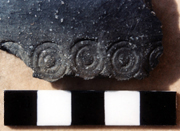
Excavation led by Ges
Moody, Trust for Thanet Archaeology; (MFC03).
A slightly larger flint-tempered sherd containing three complete and two partial stamp impressions of three concentric rings was recovered from a large ditch of at least Middle Bronze Age date, during excavations by the Trust for Thanet Archaeology at Margate Football Club in 2003 (MFC03).
A slightly larger flint-tempered sherd containing three complete and two partial stamp impressions of three concentric rings was recovered from a large ditch of at least Middle Bronze Age date, during excavations by the Trust for Thanet Archaeology at Margate Football Club in 2003 (MFC03).
This
ditch was potentially part of a settlement enclosure.
Excavation led by Adrian
Gollop, Canterbury Archaeological Trust.
Excavations at the Westwood Cross shopping centre produced a single sherd of this vessel-type (Macpherson Grant in Gardner and Moody 2005).
The shoulder sherd was 'decorated with light horizontal grooves above a row of stamps comprising three concentric circles' (Gollop 2004).
Gardner and Moody 2005; Gollop 2004.
Excavations at the Westwood Cross shopping centre produced a single sherd of this vessel-type (Macpherson Grant in Gardner and Moody 2005).
The shoulder sherd was 'decorated with light horizontal grooves above a row of stamps comprising three concentric circles' (Gollop 2004).
Gardner and Moody 2005; Gollop 2004.
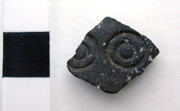
Excavation led by Jack Russell, Trust
for Thanet Archaeology; (MRR04).
This excavation produced one small flint-tempered sherd showing one complete and one partial stamp impression of two concentric rings.
It was recovered from a shallow, linear ditch.
Boast, Gardner and Moody 2006.
This excavation produced one small flint-tempered sherd showing one complete and one partial stamp impression of two concentric rings.
It was recovered from a shallow, linear ditch.
Boast, Gardner and Moody 2006.
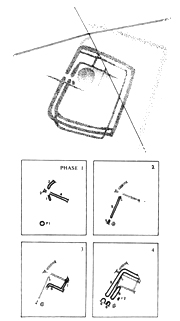
Cropmark and phased plan of the excavated part of the enclosure discovered at Shuart/Netherhale Farms
Perkins 1981
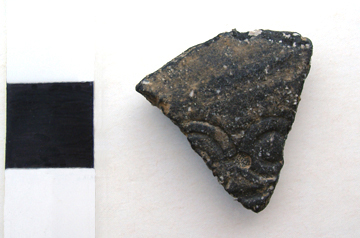
All the illustrated
examples (I -III and V) show the use of a
different circular stamp, carved with either two (I, II
and V) or three (III) concentric rings.
Three sherds
(II, III and V)
are known to be in a flint-tempered fabric, containing a fairly
frequent occurrence of generally finely crushed burnt flint. The inner
surfaces have been smoothed and the outer surfaces lightly burnished
(but not to a gloss) prior to the application of the decoration.
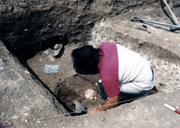
Oliver Gardner, pottery vessel and friend in a Middle Bronze Age ditch at Margate Football Club
See close-ups below
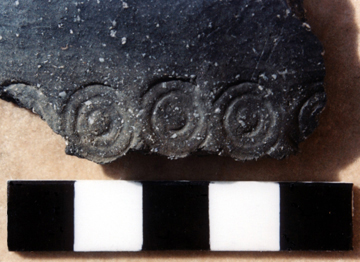
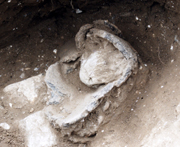
Deverel Rimbury pot
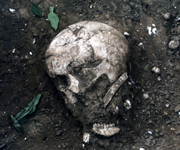
Skull
The high quality of these bowls means that plain body sherds found in isolation would be difficult to identify with certainty and could be given a much broader or later date.
The decorative scheme was once thought to be normally limited (in this area at least) to Mid-Late Iron Age finewares (Macpherson Grant 1992).
It is not known how frequently these Middle Bronze Age vessels occur in the rest of Kent, but it would prove an interesting and potentially revealing study to find other examples. As yet no ring-stamped sherds associated with Iron Age contexts have been found in Thanet.
King Edward Avenue Broadstairs
Copyright Hurd 1913
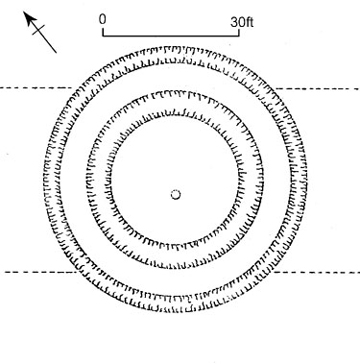
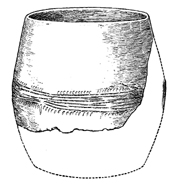
King Edward Avenue pot
Copyright Hurd 1913
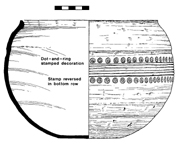
The Birchington Bowl
Illustrated by
Nigel Macpherson Grant
Hurd described the pot as coarse in character, with a fabric containing a large proportion of fine grains of quartz and shell fragments. It was ornamented with a number of roughly incised lines forming a horizontal band round the upper part of the vessel between two rows of small stabbed holes.
This discovery was originally acknowledged as being 'the first of its kind to be found in this Country'. The question is whether Hurd's vessel represents a pre-cursor to the fineware bowl forms or is perhaps more likely a local copy of what may have been a prestigious and relatively rare pot in local circulation.
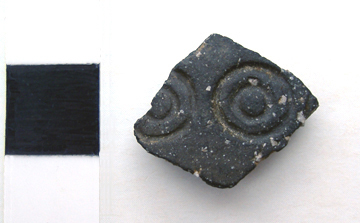
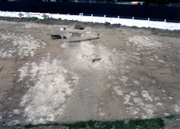
The Middle Bronze Age ditch at Margate Football Club
However the existence of the relatively more common fineware Globular Urn forms (of which a large, decorated sherd was also recovered from Margate Football Club) do demonstrate that such potting skills were present.
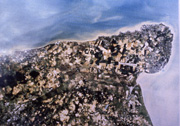
The Isle of Thanet
Copyright unknown
The potting skills needed to create such a vessel may have been more widely available but these types of vessel may have been inspired by a bronze bowl form (with the ring motif imitating rivets) that was possibly of Continental origin and was much less well known.
Nigel Macpherson Grant (1992) has suggested that the potters were copying continental styles or that the pots could have been imported.
The presence of these vessels may well reflect Thanet's contact and trading links with the Continent and represent another example of Thanet's status as a regionally important 'Gateway Community'.
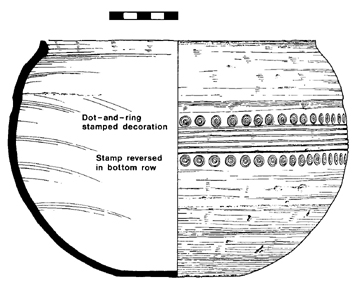
Illustrated by Nigel Macpherson Grant
Boast E.J., Gardner O.W. and Moody G.A. 2006. East Kent Community NHS Health Trust Medical Centre, Manston Road, Ramsgate, Kent. Trust for Thanet Archaeology Report.
Gardner O.W. and Moody G.A. 2005. East Kent Community NHS Health Trust medical Centre, Land Adjacent Tesco Store, Manston Road, Ramsgate. Trust for Thanet Archaeology Assessment Report.
Gollop A. 2004. Westwood Cross Broadstairs. Detailed Archaeological Investigations on land at Westwood Cross, Broadstairs, Thanet. Canterbury Archaeological Trust report, 17.
Hurd H. 1913. Proceedings of the Society of Antiquaries of London XXV, 21st November 1912 to 26th June 1913, 89-90.
Macpherson Grant N. 1992. A Review of Late Bronze Age pottery in East Kent. Canterbury's Archaeology 1991-1992, 55-63.
Perkins D.R.J. 1981. A ditched enclosure at Shuart Farm, St. Nicholas-at-Wade. Interim Excavation Reports 1977-1980. The Isle of Thanet Archaeological Unit publication, 25-29.
Powell-Cotton Major P.H.G. and Crawford O.G.S. (F.S.A.) 1924. The Birchington Hoard. The Antiquaries Journal IV, 220-226.
Much thanks go to the
Webmeister Ges Moody for the reproduction of the pictures from Hurd's
King Edward Avenue report and the Birchington Bowl.
Version 1 - Posted 25.06.06
Version 2 - Posted 27.07.06
Version 3 - Posted 21.10.06
All
content © Trust for Thanet Archaeology